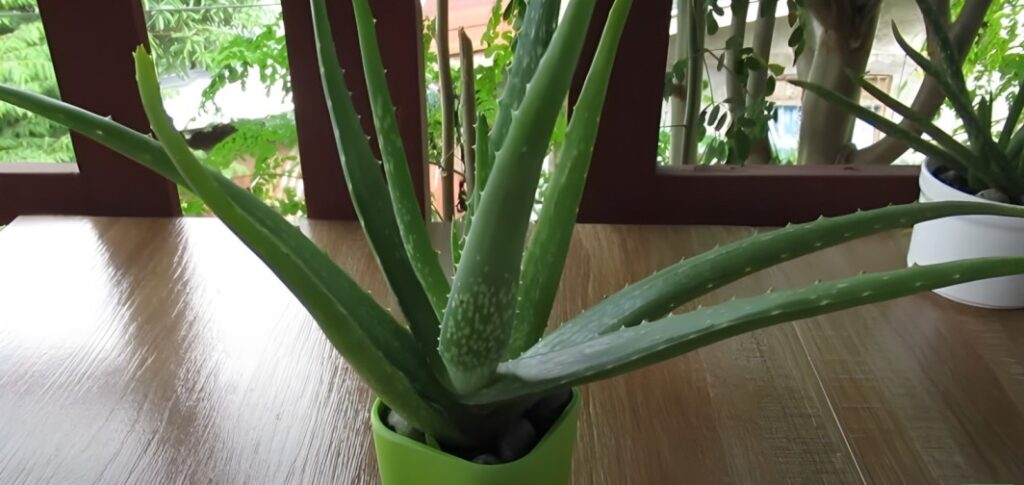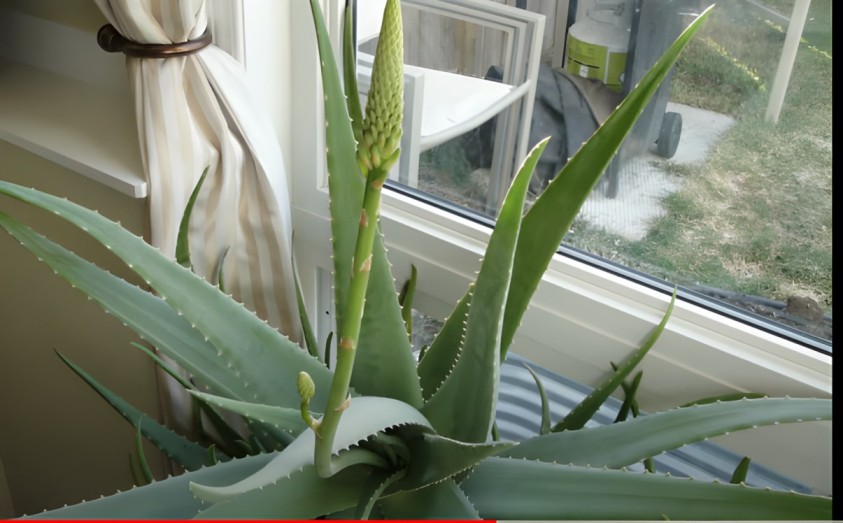Why are My Aloe Vera Leaves Bending: Causes & Solutions (2024)
The Aloe Vera Leaves Bending serves to indicate potential stressors in the plant. The curving could be caused by lack of sunlight, overwatering, under-watering, temperature changes or even pests.
The effect on the plant is significant given that these succulents mainly store water in their leaves to counter arid conditions. However, much folding or bending may interfere with plants’ capacity to capture sunlight effectively and photosynthesize.

In turn, this can negatively impact the production of essential substances and seriously affect the general health and vitality of Aloe Vera. In this article, we shall look at the causes and management of why are aloe vera laeves bending.
Contents
- 1 Reasons Why Is My Aloe Vera Leaf Bent?
- 2 Can You Fix Aloe Vera Plant Leaves Bending?
- 3 How to fix an aloe vera with droopy leaves?
- 4 Should I trim drooping aloe vera leaves?
- 5 What to do with bent aloe vera leaves?
- 6 Aloe Vera Leaves Bending care: Navigating Leaf, Color, Structural, and Unconventional Issues
- 7 Conclusion
- 8 FAQs
- 8.1 What does it mean when aloe vera leaves bend?
- 8.2 Why is my aloe plant creasing?
- 8.3 Why is my aloe plant curving?
- 8.4 Can a bent aloe leaf heal?
- 8.5 What to do when aloe leaves bend?
- 8.6 Why are my aloe leaves folding?
- 8.7 What causes Aloe vera leaves to droop?
- 8.8 How do you fix a droopy Aloe plant?
- 8.9 Where and How To Cut Healthy Aloe Vera Leaves For Use?
Reasons Why Is My Aloe Vera Leaf Bent?
Inadequate sunlight
Have you ever noticed an Aloe Vera Leaves Bending? Insufficient sunlight may be the reason. The sun-loving aloe vera tends to bend its leaves when there is a lack of adequate light.
The plant depends on light for many important processes such as photosynthesis and its lack results in the growth deformation of the plant.
How to Fix it
First, move your plant to a sunnier location but make sure that it is getting at least 6 hours of indirect sunlight every day. Rotate the pot occasionally for even growth. In case of deficit in natural light, use a grow light as an additive.
Watering Habits
However, curious about why your previously erect Aloe Vera Leaves Bending? In most cases, the real culprit lies in your watering practices. Overwatering or underwatering can cause your plant to dance on its leaves.
Aloe vera is very low maintenance but likes soil that drains well. If the plant is overwatered, roots starve, and leaves turn limp and bend.
How to Fix it
For overwatering, wait for the ground to dry before watering. Make sure the pot has drain holes and if the soil keeps soggy consider repotting it. On the other hand, with underwatering at stake, water your aloe when the top inch of soil is dry.
Inadequate soil mix/lack of drainage
But, are your aforementioned aAloe Vera Leaves Bending low and leaving you confused? One of the common causal factors is insufficient soil combination or lack of appropriate drainage.
Aloe vera plants grow best in soil with good drainage and when they don’t get that, their leaves will often bend either from overwatering or waterlogged roots. To address this, consider repotting your aloe vera in a combination of cactus soil or sandy soil that lets water drain out quickly.
How to Fix It
- Replant in Well-Draining Soil: Consider finding a cactus mix or adding sand to your current soil in order to improve drainage.
- Adjust Watering Routine: Water your plants when the top inch of soil is dry to the touch.
- Optimize Pot Size: To prevent the accumulation of water, use a pot with drainage holes.
- Provide Adequate Sunlight: Provide enough sunlight to your aloe vera so that it grows well.
Temperature change
Have you observed your formerly straight Aloe Vera Leaves Bending an interesting twist? Well, temperature fluctuations could be the cause.
Sharp changes in the weather can make aloe vera plants’ leaves bend or curl due to their sensitivity. This may be caused by subjecting the plant to sudden cold drafts or excess heat.
How to Fix it
Regulate Environment: Also, aloe vera should be kept in a constant climate and avoid temperature changes.
Provide Adequate Light: Make sure your plant receives bright but indirect light to adjust it slowly to temperature fluctuations.
Protect from Drafts: In order to protect your aloe vera from cold drafts, keep it away from open windows or doors during the periods of winter.
Stress
You may have noticed those Aloe Vera Leaves Bending elegantly and wondered why? Stress might be the culprit! Your resistant succulent also reacts to conditions like insufficient light, over watering or sudden change of environment.
How to Fix it
First, assess its light exposure as aloe veras prefer bright but indirect light. Then, consider your watering routine they do not like wet roots therefore; leave them dry before applying water again. Similarly, make sure that your pot is properly drained to avoid waterlogged roots.
Fungal Disease
Have you seen your previously erect aloe vera leaves bending against the flow of expectation? The causative agents may possibly be a fungal pathogen that destroys the structural integrity of the plant.
Fungal diseases weaken the leaves’ ability to maintain stiffness, which can result in leaf bending or curling. Early detection is crucial; the first signs may include leaf discoloration, abnormal spots or fuzzy leaves.
How to Fix it
To address this fungal threat, change the watering schedule. Overwatering results in a moist environment favorable to fungus, so water only when necessary. Trim affected leaves carefully using sterilized tools to contain the disease.
Bacterial Soft Rot
Have you witnessed your beloved Aloe Vera Leaves Bending? The perpetrator could be a feared enemy of plants Bacterial Soft Rot.
This destructible intruder secretes its way into your plant where the leaves curl and soften. The bacteria flourish in environments that are too wet and this can be caused by overwatering or poor drainage.
How to Fix It
- Assess Watering Habits: Remember not to drown your aloe vera. Allow the soil to dry out between watering in an effort to prevent bacterial proliferation.
- Improve Drainage: Plant your aloe vera in soil with good drainage and a container that drains water. This simple adjustment can avoid waterlogging conditions.
- Prune Affected Leaves: Cut any mushy or discolored leaves from the infected area to curb the spread of bacteria.
Improper Container Characteristics or Size
When the Aloe Vera Leaves Bending over, it is somewhat strange to see but do not worry – most often it reflects inappropriate container characteristics or size.
When the pot is small or improperly drained, aloe roots fail to develop properly and have an insufficient supply of oxygen. This limitation causes leaves to bend and be weak due to the need for balance.
How to Fix It
Give the aloe plant better living conditions by using a bigger, well draining pot. Consider using containers having perforations or drainage holes to prevent waterlogged soil and thus ensure healthy root growth.
Besides, think of a combination of cacti or succulants in order to boost aloe’s health. Also, the new pot should be 1-2 inches bigger in width than the current one and leave plenty of space for the growing roots. Repot during summer to facilitate the transition process.

Can You Fix Aloe Vera Plant Leaves Bending?
Aloe Vera Leaves Bending present an unpleasant sight to plant lovers but here, have no fear! These minor adjustments in the way that an aloe vera is taken care of can restore its health immediately.
Now, let’s take a closer look at the critical factors contributing to those annoying angles and discuss successful treatments.
Optimizing Light Exposure
Make sure that your aloe vera is exposed to the correct amount of light. Although these plants thrive in sunlight, an excessive amount of it can cause the leaves to droop.
Position your aloe vera in a bright location that doesn’t receive direct afternoon sunlight. Rotate the pot every so often for uniform lighting.
Smart Watering Practices
Overwatering or malnourishment may be the cause of leaf problems. Maintain regular watering, ensuring that the ground dries between sessions.
Place the plants in well-drained pots to avoid waterlogged roots. Remember that aloe vera likes slightly drier conditions to reflect its arid origin.
Temperature Control
Aloes are comfortable in conditions that are moderately warm, and extremes of heat can even cause leaf issues. Shield the plant from temperature fluctuations, drafts, or cold spells. The best temperature range for growth is 59-77°F (15-25°C).
Choosing the Right Potting Soil
Pot your aloe vera in well-draining soil mix like cactus or succulent blend. These mixtures prevent water accumulation, thus ensuring healthier roots and reduced bending.
Strategic Fertilizing
Feed your aloe vera slowly, usually during the spring and summer seasons. Apply balanced, dilute fertilizer, decreasing the amount applied during dormant winter phases.
Excessive fertilizing leads to problems with the leaves, therefore moderation is very essential. So for these all strategies we can solve the issue of aloe vera leaves bending.
How to fix an aloe vera with droopy leaves?
Don’t let your aloe vera cower with droopy leaves! It turns out to be easier than it seems. This is either due to overwatering or insufficient sunlight.
- Overwatering: When it comes to water, Aloe does better on neglect. Water when the soil is completely dry between each watering generally every 2-4 weeks. When the soil gets soggy, leaves droop down because the roots rot. If this occurs, take the aloe out of the pot, cut off any rotten roots and repot in a soil mix that allows drainage. Wait for a week or two before watering.
- Lack of sunlight: The primary need of the aloe is to be in the sunshine for at least 6 hours every day. Place them by a bright window or take them outside for summer. The weak leaves that result from insufficient light won’t perk up and straighten, but new growth will be just the opposite if sufficient sunshine is provided.
- Pruning: Trim off the damaged or sick leaves and let the plant divert energy to healthier growth. With these parameters reformed in the regime of watering, lighting and pruning, your aloe vera will stand positively and vividly.
Should I trim drooping aloe vera leaves?
- Cut the drooping leaf near its base using sharp scissors or pruners.
- Slightly drooping or discolored leaves? These are probably fine. For some, they may just need their care routine adjusted (more/less water or increased light) and they will bounce back.
- Brown, shriveled, or mushy leaves? These may be dead or dying and could be cleared. To prevent rot and encourage the growth of new shoots, cut them off at their base with a clean sharp knife.
- Leaves bending at sharp inclines or falling off? This might be an indication of the root rot due to waterlogging. Check the roots and repot in drainage medium if needed. You can also attempt to prune away a few of the lower leaves in order to enhance better ventilation.
What to do with bent aloe vera leaves?
The causes of the bending may include overwatering, insufficient light or damage. Greatly bend the following sentence. If the leaf is slightly bent, it may be simply straightened out with a slight support or by shifting its position. On the other hand, if there is excessive bending or the leaf is damaged, you should cut it off with clean scissors or pruning shears.
Below are some ideas for the bendy aloe vera
- Harvest the gel: The good inside the leaf remains perfectly viable. Simply peel off the skin, rinse it thoroughly, and take out the jelly. You can use it for a sunburn, cuts, drier skin or even add it into a smoothie.
- Propagate a new plant: Cut the deformed leaf and let if sit for a couple of days in a dark place to develop a callose. This should be planted in a well-draining soil and kept moist until roots emerge. In time, you will get your new aloe baby.
- Compost it: If the leaf is brown or mushy, it has peaked. But don’t toss it! Break it up and toss in the compost heap. It will decompose and provide essential nutrients to your soil.

A perplexing array of issues plagues my aloe vera plant, and I find myself bewildered by the diverse symptoms manifesting in its leaves. The once vibrant foliage is now a canvas of concerns, encompassing leaf issues that range from bending and drooping to turning brown, thinning, and curling in various directions.
Some leaves even exhibit a distressing combination of curling and browning, while others are turning brown and dry. It’s as if a spectrum of colors and textures has emerged within this cluster of leaf-related problems, with shades ranging from orange and purple to pink, pale, white, yellow, and even black.
Concurrently, the overall color of the plant is undergoing transformations, as observed in the plant color changes cluster. The once resilient plant is now struggling with issues like turning brown and soft, developing brown tips, and even transitioning to different hues like grey, gray, dark green, and light brown.
As I contemplate the leaf and color dilemmas, I’m also confronted with structural concerns that further perplex me. The leaves are not just bending; they exhibit a variety of structural issues, bending at joints, knees, and even nails. The bending is occurring quickly, leaving me to wonder about the plant’s overall stability.
A diverse set of questions arise, from how to cut aloe vera leaves to the precise angles at which the leaves are bending—be it 0.5 mm, 10mm, or even a perplexing 90 degrees. Amidst these complexities, I stumble upon a cluster of other issues encompassing aloe vera care guides, uses, and unconventional suggestions such as aloe vera for hair leave-in treatments.

It seems my aloe vera plant is not just struggling with the basics but is entangled in a web of peculiarities, including advice on YouTube about aloe vera propagation, the intriguing notion of aloe vera for burns (Verbrennungen 2 grades), and the enigma of 7 leaves aroma and liquid.
This journey into the intricacies of aloe vera care transcends the conventional, touching upon diverse topics such as plant trimming techniques (stutzen), cross-sectional insights (querschnitt), and even the seemingly unrelated realms of Aloe Vera C9.
As I navigate this labyrinth of issues, including the curious instances of leaves bending zinc, 0.5 mm, and 10mm, I’m left contemplating the intricate dance between the plant’s physiological well-being and the myriad external factors influencing its peculiar behavior, represented by clusters such as aloe vera leitfaden and aloe vera leave-in selber machen.
It becomes evident that understanding and addressing these multifaceted challenges demand a holistic approach, delving into the plant’s biology, care techniques, and perhaps even exploring unconventional solutions.
Conclusion
In conclusion, the issues with aloe vera leaves bending are addressed by a holistic approach that takes into account many factors affecting the health of the plant.
While root rot or fungal diseases, bacterial soft rots, temperature fluctuation, and other problems occur due to poor lighting, and watering habits low temperatures cause stress that might compromise the health of your plant’s roots.
By managing proper light exposure, watering carefully, regulating temperature variations, choosing suitable potting soil, or fertilizing smartly you can restore the upright stance of your aloe vera and aid its development.
FAQs
What does it mean when aloe vera leaves bend?
Bending aloe vera leaves usually mean stress, or environmental problems. Reasons may include lack of sunlight, watering issues or even temperatures and fungal infections. It is identifying the specific cause that helps in providing targeted solutions.
Why is my aloe plant creasing?
Aloe plants can experience a reducing in size due to a number of circumstances, including physical harm and overwatering or underwatering. Preventing more creasing can be achieved by evaluating the plant’s watering schedule and removing any environmental stresses.
Why is my aloe plant curving?
Stress from the climate, inadequate sunshine, or problems with watering can cause aloe plants to bend. Aloe leaf curvature may be corrected by providing enough light, modifying watering schedules, and preserving a steady atmosphere.
Can a bent aloe leaf heal?
An aloe leaf that is slightly bent might not entirely recover, but the plant can focus its efforts on developing new, healthier growth. Removing leaves that are badly damaged improves the general health of the plant.
What to do when aloe leaves bend?
Determine the underlying reason of bending aloe leaves, whether it is due to temperature, light, watering, or other causes. Taking into account elements such as repotting, trimming, or maximizing environmental conditions, modify the care regimen as necessary.
Why are my aloe leaves folding?
When aloe leaves are exposed to too much sunshine or not enough water, they might fold. To avoid folding, modify the watering schedule so that the soil is not very dry or soggy, and offer enough shade.
What causes Aloe vera leaves to droop?
Aloe vera leaves may droop as a result of problems with soil drainage, overwatering, underwatering, or insufficient sunshine. Drooping may be minimized by maximizing light exposure and making appropriate adjustments to watering practices.
How do you fix a droopy Aloe plant?
A drooping aloe plant may be straightened by allowing the soil to dry out in between waterings, making sure that drainage is adequate, and getting enough indirect sunshine. Recuperation can also be facilitated by trimming off leaves that are badly damaged.
Where and How To Cut Healthy Aloe Vera Leaves For Use?
Trim healthy aloe vera leaves close to the root using a knife or a pair of clean, sharp scissors. Select outer leaves, being careful to preserve some lower leaves for the health of the plant. When you harvest from the bottom, the plant’s younger leaves may develop and renew itself.






